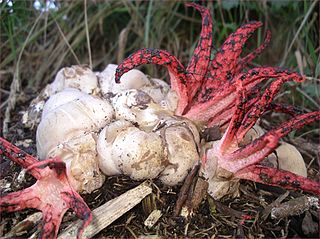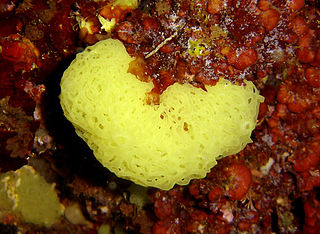
Lactobacillus is a genus of gram-positive, aerotolerant anaerobes or microaerophilic, rod-shaped, non-spore-forming bacteria. Until 2020, the genus Lactobacillus comprised over 260 phylogenetically, ecologically, and metabolically diverse species; a taxonomic revision of the genus assigned lactobacilli to 25 genera.

Phallaceae is a family of fungi, commonly known as stinkhorns, within the order Phallales. Stinkhorns have a worldwide distribution, but are especially prevalent in tropical regions. They are known for their foul-smelling, sticky spore masses, or gleba, borne on the end of a stalk called the receptaculum. The characteristic fruiting-body structure, a single, unbranched receptaculum with an externally attached gleba on the upper part, distinguishes the Phallaceae from other families in the Phallales. The spore mass typically smells of carrion or dung, and attracts flies, beetles and other insects to help disperse the spores. Although there is great diversity in body structure shape among the various genera, all species in the Phallaceae begin their development as oval or round structures known as "eggs". The appearance of Phallaceae is often sudden, as gleba can erupt from the underground egg and burst open within an hour. According to a 2008 estimate, the family contains 21 genera and 77 species.

Clathrus is a genus of fungi of the family Phallaceae, the stinkhorn fungi. Mature fruit bodies are covered with olive-brown slimy gleba, containing spores, that attract flies. These fungi are saprobic and are common in mulch.
Syllomus is an extinct genus of sea turtle from the Miocene-age deposits in the US Eastern Seaboard and Egypt.

Clathrus archeri, commonly known as octopus stinkhorn or devil's fingers, is a fungus which has a global distribution. This species was first described in 1980 in a collection from Tasmania. The young fungus erupts from a suberumpent egg by forming into four to seven elongated slender arms initially erect and attached at the top. The arms then unfold to reveal a pinkish-red interior covered with a dark-olive spore-containing gleba. In maturity it smells like putrid flesh.

Clathrus ruber is a species of fungus in the family Phallaceae, and the type species of the genus Clathrus. It is commonly known as the latticed stinkhorn, the basket stinkhorn, or the red cage, alluding to the striking fruit bodies that are shaped somewhat like a round or oval hollow sphere with interlaced or latticed branches. The species was illustrated in the scientific literature during the 16th century, but was not officially described until 1729.

Clathrus columnatus, commonly known as the column stinkhorn, is a saprobic species of basidiomycete fungus in the family Phallaceae. Similar to other stinkhorn fungi, the fruiting body, known as the receptaculum, starts out as a subterranean "egg" form. As the fungus develops, the receptaculum expands and erupts out of the protective volva, ultimately developing into mature structures characterized by two to five long vertical orange or red spongy columns, joined at the apex. The fully grown receptaculum reaches heights of 8 cm tall. The inside surfaces of the columns are covered with a fetid olive-brown spore-containing slime, which attracts flies and other insects that help disseminate the spores.

Clathrina clathrus is a species of calcareous sponge belonging to the family Clathrinidae.
Ascandra contorta is a species of calcareous sponge belonging to the family Clathrinidae.

Clathrus chrysomycelinus is a species of fungus in the stinkhorn family. It is found in South America and reported from New Zealand, although the equivalence of the species is yet to be determined.

Clathrus crispus is a species of fungus in the stinkhorn family. Reported as new to science in 1820, it is found in the Americas.
Clathrus cristatus is a species of fungus in the stinkhorn family. Found in Brazil, it was described as new to science in 2010.
Clathrus kusanoi is a species of fungus in the stinkhorn family. It is known only from Japan.
Clathrus mauritianus is a species of fungus in the stinkhorn family. It is found in Mauritius.

Clathrus treubii is a species of fungus in the stinkhorn family. It is found in Indonesia and Malaysia.
Clathrus xiningensis is a species of fungus in the stinkhorn family. Found in China, it was described as new to science in 1994.
Lactobacillus iners is a species in the genus Lactobacillus. It is a Gram-positive, catalase-negative, facultatively anaerobic rod-shaped bacterium. Lactobacillus iners is a normal inhabitant of the lower reproductive tract in healthy women.
Lactobacillus crispatus is a common, rod-shaped species of genus Lactobacillus and is a hydrogen peroxide (H2O2) producing beneficial microbiota species located in both the vagina, through vaginal discharge, and the vertebrate gastrointestinal tract. The strain CTV-05 is used as a probiotic that can be used by premenopausal and postmenopausal women that experience recurrent urinary tract infections. It is being evaluated specifically for the prevention and treatment of bacterial vaginosis, which is characterized by the absence of Lactobacillus flora necessary to protect the host from infection.

Loxorhynchus crispatus, known generally as the masking crab or moss crab, is a species of true crab in the family Epialtidae. It is found in the East Pacific.
LACTIN-V, also known as CTV-05 or as Lactobacillus crispatus CTV-05, is a live biopharmaceutical medication containing a strain of Lactobacillus crispatus (L. crispatus) which is under development for the treatment of urinary tract infections (UTIs) and bacterial vaginosis (BV). It is administered intravaginally and is described as the first vaginal microbiome (VMB)-based live biotherapeutic product (LBP). Depletion of hydrogen peroxide (H2O2)-producing Lactobacillus strains such as Lactobacillus crispatus in the vagina has been strongly associated with BV and UTIs. Most commercially available probiotic Lactobacillus strains are not vaginal strains and do not appear to improve vaginal or urinary health outcomes. The Centers for Disease Control and Prevention (CDC)'s Sexually Transmitted Infections Treatment Guidelines (2021) noted that intravaginal LACTIN-V produced a considerably lower recurrence of BV following initial antibiotic treatment with metronidazole in a randomized controlled trial. However, the guidelines also noted that LACTIN-V is not yet Food and Drug Administration (FDA)-approved or commercially available. As of December 2021, LACTIN-V is in phase 2/3 clinical trials for the treatment of UTIs and is in phase 2 trials for the treatment of BV. It was originated by GyneLogix and is under development by Osel Inc., the National Institute of Allergy and Infectious Diseases, and other organizations.









